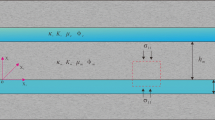Abstract
This article is concerned with tortuosity effects in coupled transport and mechanical properties of fractured geomaterials. Experimental results on confined fractured argillite samples are presented in terms of (1) progressive fracture reclosure and (2) fracture in plane permeability evolution, both depending upon confinement intensity. The observed non-linear mechanical response (fracture reclosure law) is physically interpreted as the progressive reclosure of local pores. The weak correlation between mechanical and hydraulic measurements is attributed to tortuosity effects which enhance the initial decrease of the permeability. The classical Self-Consistent scheme is herewith developed to qualitatively and quantitatively give theoretical basis likely to account for these tortuosity effects on permeability evolution.
Similar content being viewed by others
References
Barthélémy J.-F.: Effective permeability of media with a dense network of long and micro fractures. Transp. Porous Med. 76(1), 153–178 (2009)
Berkowitz B.: Analysis of fracture network connectivity using percolation theory. Math. Geol. 27(4), 467–483 (1995)
Berkowitz B.: Characterizing flow and transport in fractured geological media: a review. Adv. Water Resour. 25, 861–884 (2002)
Bernabe Y., Brace W.: Permeability porosity pore geometry hot pressed calcite. Mech. Mater. 1(3), 173–183 (1982)
Budiansky B., O’Connell R.: Elastic moduli of a cracked solid. Int. J. Solids Struct. 12, 81–97 (1976)
Cook N.: Natural joints in rock: mechanical, hydraulic and seismic behaviour and properties under normal stress. Int. J. Rock Mech. Min. Sci. Geomech. Abstr. 29, 198–223 (1992)
Davy C.A., Skoczylas F., Barnichon J.-D., Lebon P.: Permeability of macro-cracked argillite under confinement: gas and water testing. Phys. Chem. Earth 32, 667–680 (2007)
Deudé V., Dormieux L., Kondo D., Maghous S.: Micromechanical approach to non-linear poroelasticity: application to cracked rocks. J. Eng. Mech. ASCE 128(8), 848–855 (2002)
Dormieux L., Kondo D.: Approche micromécanique du couplage perméabilité-endommagement. Comptes Rendus de Mécanique 332(2), 135–140 (2004)
Dormieux L., Lemarchand E.: Modélisation macroscopique du transport diffusif: apport des méthodes de changement d’échelle d’espace. Oil & Gas - Revue de l’Institut Francais du Pétrole 55(1), 15–34 (2000)
Dormieux L., Lemarchand E.: A homogenization approach of advection and diffusion in cracked porous material. J. Eng. Mech. ASCE 127(12), 1267–1274 (2001)
Dormieux L., Kondo D., Ulm F.-J.: Microporomechanics. Wiley, New York (2006)
Eshelby J.: The determination of the elastic field of an ellipsoidal inclusion, and related problems. Proc. R. Soc. Lond. A241, 235–251 (1957)
Guegen Y., Palciauskas V.: Introduction à la Physique des Roches. Hermann, Paris (1992)
Guéguen Y., Chelidze T., Ravalec M.L.: Microstructures, percolation thresholds and rock physical properties. Tectonophysics 279, 23–35 (1997)
Iwai, K.: Fundamental studies of fluid flow through a single fracture. PhD thesis, University of California, Berkeley, CA (1976)
Jaeger, J., Cook, N., Zimmerman, R.: Fundamentals of Rock Mechanics, 4th edn. Volume ISBN: 9780632057597, ISBN10: 0632057599. Blackwell Publishing (2007)
Lemarchand, E.: Contribution de la micromécanique à l’étude des phénomènes de transport et de couplage poromécanique dans les milieux poreux: Application aux phénomènes de gonflement dans les géomatériaux. PhD thesis, École nationale des ponts et chaussées, Paris, France (2001)
Lemarchand E., Davy C.A., Dormieux L., Chen W., Skoczylas F.: Micromechanics contribution to coupled transport and mechanical properties of fractured geomaterials. Transp. Porous Med. 79(3), 335–358 (2009)
Loosveldt H., Lafhaj Z., Skoczylas F.: Experimental study of gas and liquid permeability of a mortar. Cem. Concr. Res. 32, 1357–1363 (2002)
Meziani H., Skoczylas F.: An experimental study of the mechanical behaviour of a mortar and of its permeability under deviatoric loading. Mater. Struct. 32, 403–409 (1999)
Montemagno C., Pyrak-Nolte L.: Porosity of natural fracture networks. Geophys. Res. Lett. 22(11(HS)), 1397–1400 (1995)
Murata S., Saito T.: Estimation of tortuosity of fluid flow through a single fracture. J. Can. Pet. Technol. 42(12), 39–45 (2003)
Neuzil C., Tracy J.: Flow through fractures. Water Resour. Res. 17(1), 191–199 (1981)
Oron A., Berkowitz B.: Flow in rock fractures: the local cubic law assumption reexamined. Water Resour. Res. 34(11), 2811–2825 (1998)
Podzniakov S., Tsang C.-F.: A self-consistent approach for calculating the effective hydraulic conductivity of a binary, heterogeneous medium. Water Resour. Res. 40(W05105), 1–13 (2000)
Pyrak-Nolte L., Cook N., Nolte D.: Fluid percolation through single fractures. Geophys. Res. Lett. 15(11), 1247–1250 (1988)
Sausse J.: Hydromechanical properties and alteration of natural fracture surfaces in the Soultz granite (Bas-Rhin, France). Tectonophysics 348, 169–185 (2002)
Sisavath S., Al-Yaaruby A., Pain C., Zimmerman R.: A simple model for deviations from the cubic law for a fracture undergoing dilation or closure. Pure Appl. Geophys. 160(5/6), 1009–1022 (2003)
Skoczylas, F.: Ecoulements et couplages fluide-squelette dans les milieux poreux. Etudes expérimentales et numériques. Mémoire d’Habilitation à Diriger des Recherches, Université des Sciences et Technologie de Lille, France (1996)
Tsang Y.: The effect of tortuosity on fluid flow through a single fracture. Water Resour. Res. 20(9), 1209–1215 (1984)
Tsang Y., Tsang C.: Channel model of flow through fractured media. Water Resour. Res. 23(3), 467–479 (1987)
Tsang Y., Witherspoon P.: The dependence of fracture mechanical and fluid flow properties on fracture roughness and sample size. J. Geophys. Res. 88(B3), 2359–2366 (1983)
Viggiani G. et al.: X-ray microtomography for studying localized deformation in fine-grained geomaterials under triaxial compression. Comptes Rendus de Mécanique 332, 819–826 (2004)
Walsh J., Brown S., Durham W.: Effective media theory with spatial correlation for flow in fracture. J. Geophys. Res. 102(B10), 22587–22594 (1997)
Walters D., Wong R.: The hydraulic and mechanical response of an oil sand fracture under varying confining pressure. Can. Geotech. J. 36(2), 262–271 (1999)
Wanfang Z., Wheater H., Johnston P.: State of the art of modelling two-phase flow in fractured rock. Environ. Geol. 31(3/4), 157–166 (1997)
Zimmerman, R., Yeo, I.: Fluid Flow in Rock Fractures: From the Navier-Stokes Equations to the Cubic Law. American Geophysical Union (2000)
Zimmerman R., Chen D., Cook N.: The effect of contact area on the permeability of fractures. J. Hydrol. 139(1–4), 79–96 (1992)
Author information
Authors and Affiliations
Corresponding author
Rights and permissions
About this article
Cite this article
Lemarchand, E., Davy, C.A., Dormieux, L. et al. Tortuosity Effects in Coupled Advective Transport and Mechanical Properties of Fractured Geomaterials. Transp Porous Med 84, 1–19 (2010). https://doi.org/10.1007/s11242-009-9481-3
Received:
Accepted:
Published:
Issue Date:
DOI: https://doi.org/10.1007/s11242-009-9481-3




